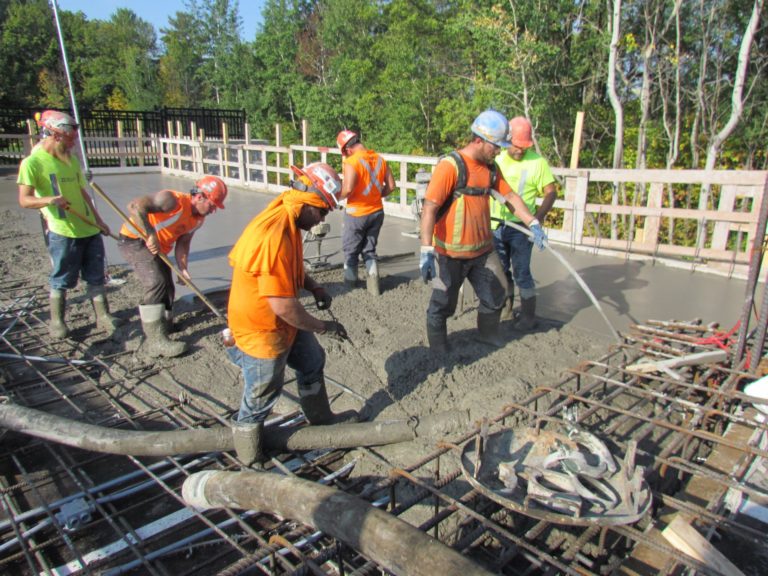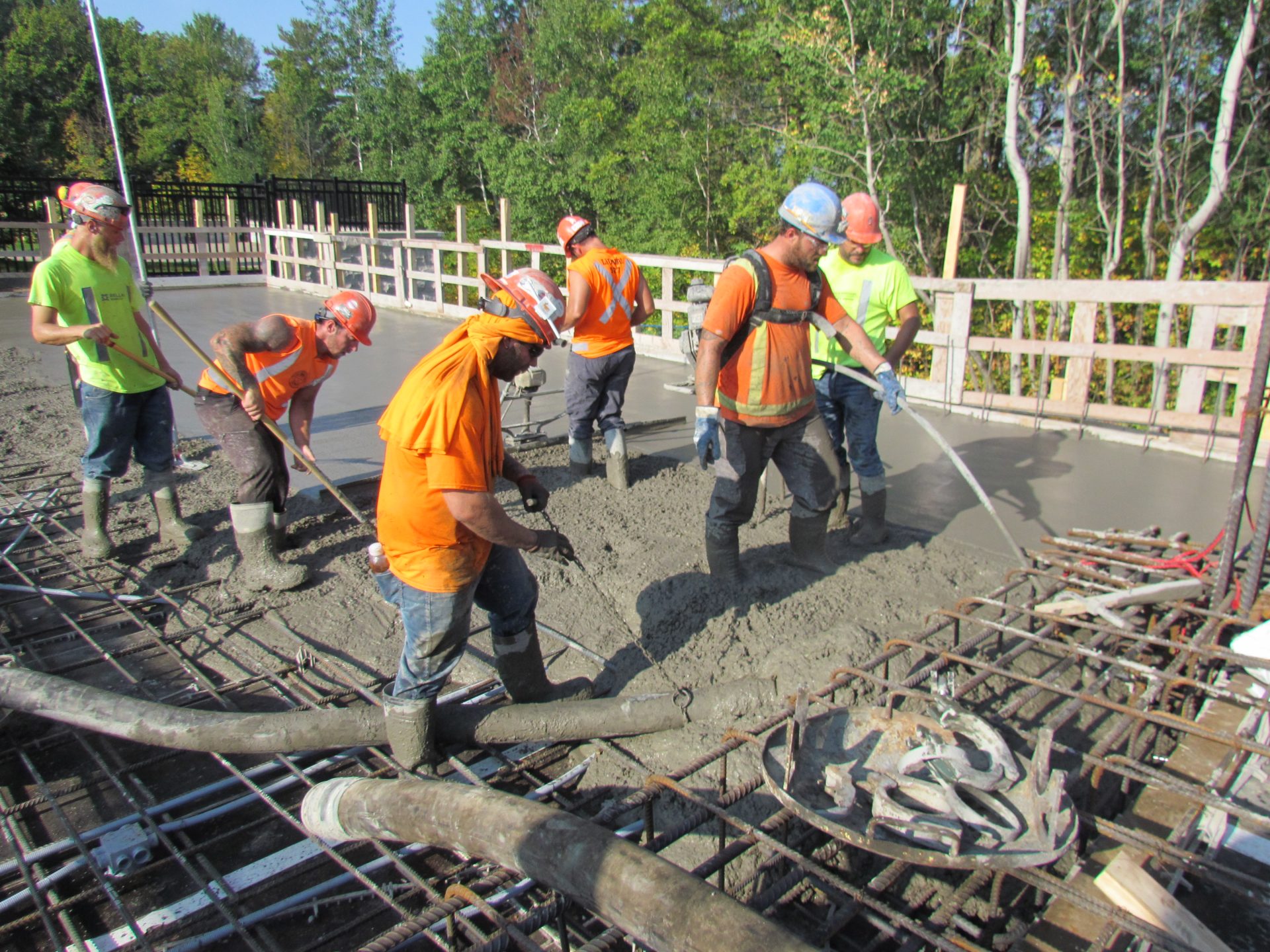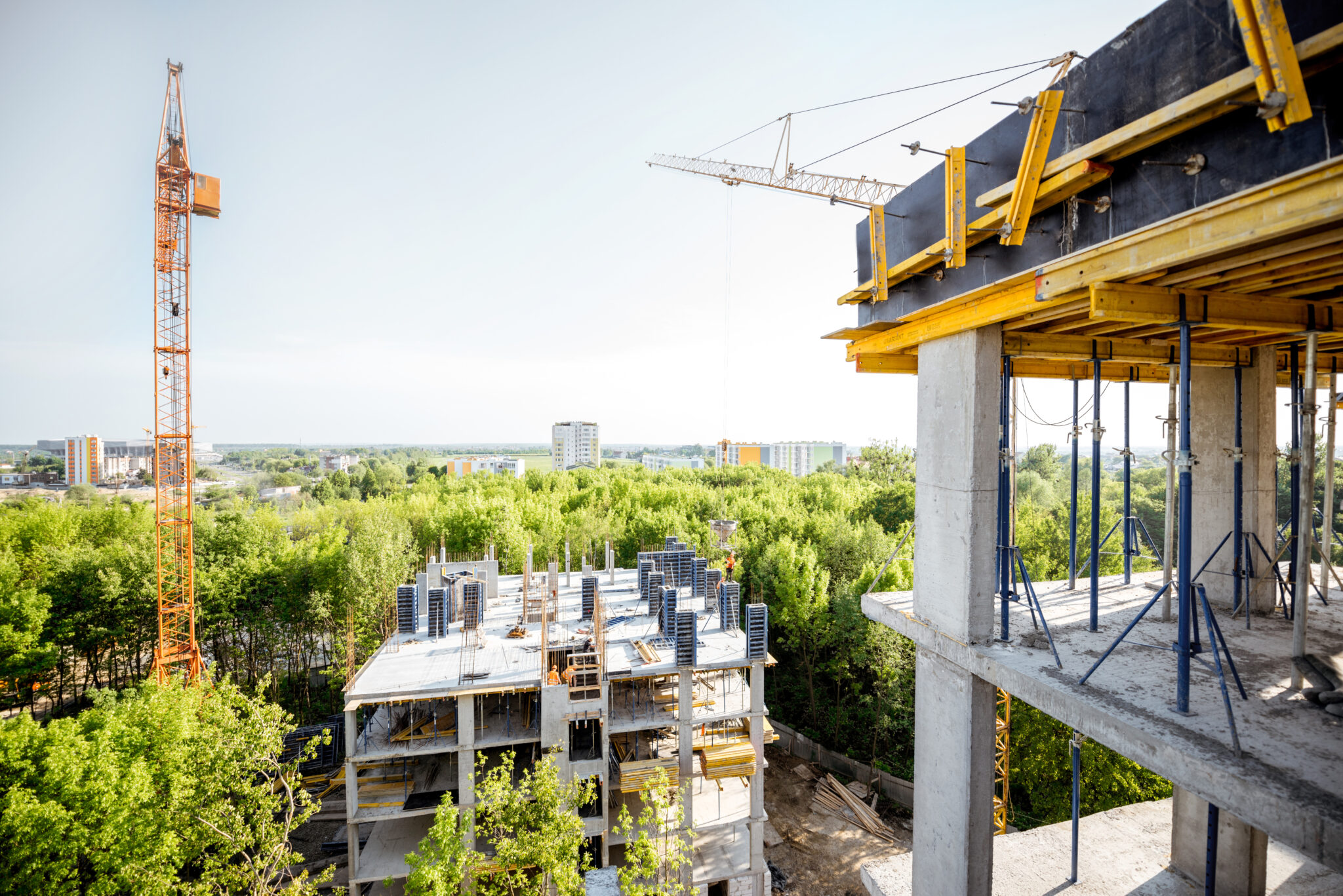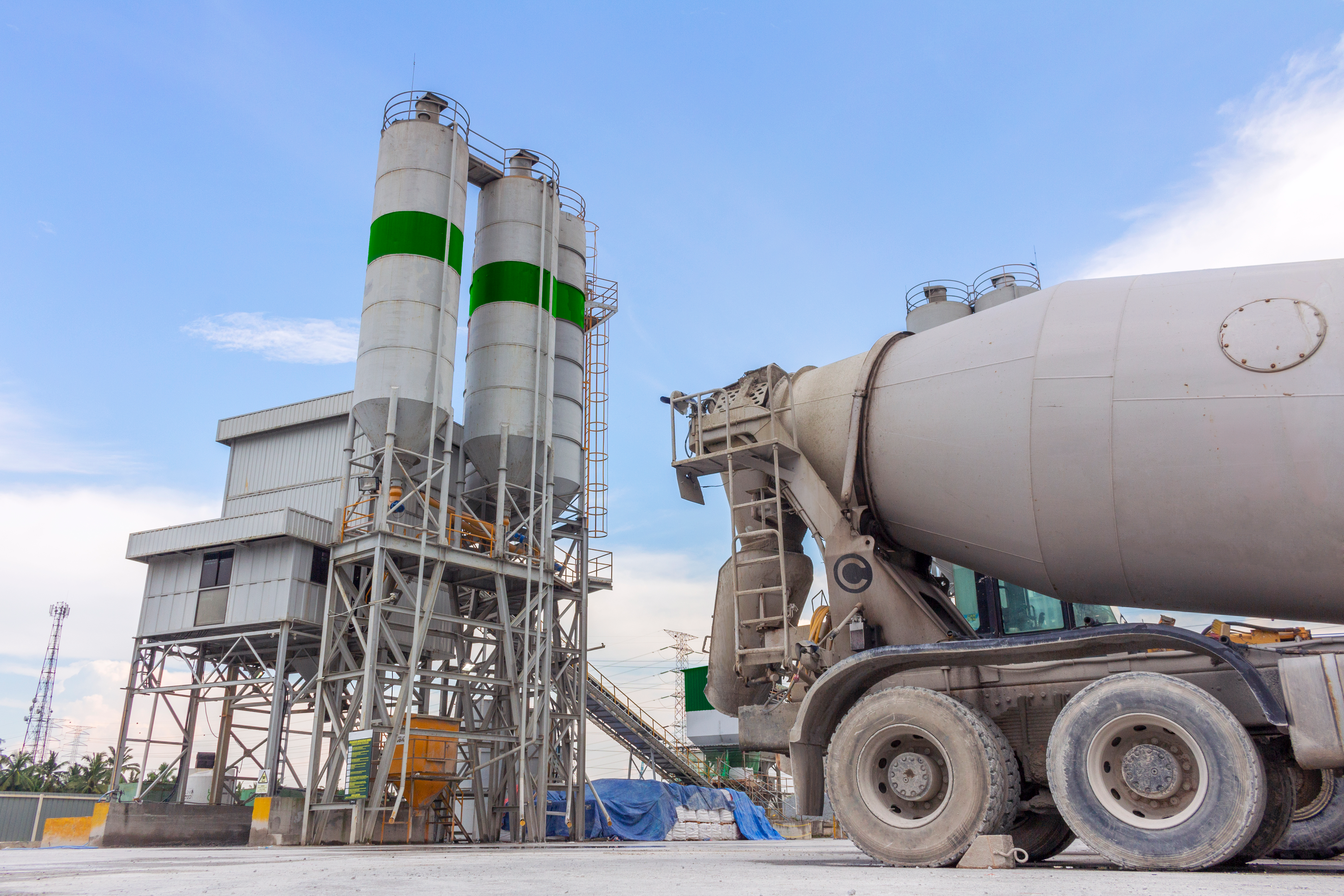When it comes to concrete measurement, specifically concrete field strength monitoring, it is important for project managers to consider the impact that each technique will have on their schedule. While some testing processes can be done directly onsite, others require extra time in external facilities that deliver strength data. Time is not the only factor that contributes to project managers’ decisions. The accuracy of the testing process is just as important as it directly affects the concrete quality of the structure.
Biggest SmartRock® Savings of the Year are Here!
Understanding Concrete Strength
Concrete strength is a critical measure of how well a concrete mix can withstand external forces without breaking or failing. It’s typically measured in terms of compressive strength, which refers to the material’s ability to resist crushing forces.
The strength of concrete depends on several factors, including the quality of the raw materials, the water-to-cement ratio, the curing process, and environmental conditions during and after the pour.
Accurately determining concrete strength is essential for ensuring the structural integrity and safety of buildings, bridges, and other concrete infrastructure. With modern advancements like wireless sensors, construction professionals can now monitor this vital parameter in real-time. These innovations provide more precise data and reduce the risk of premature failures.
What’s the Most Common Concrete Strength Test?
The most common method for monitoring the strength of in-situ concrete is the use of field-cured cylinders. This practice has remained generally unchanged since the early 19th century. These samples are cast and cured according to ASTM C31 and tested for compressive strength at various stages. Usually, if the slab has reached 75% of its designed strength, engineers will give the go-ahead to their team to move on to the next steps in the construction process.
There have been many developments to speed up the curing process since this testing method was first introduced. This includes the use of heating blankets, additives, and vapor retarders, etc. However, contractors still wait three days after their pour before testing for strength, even though their targets are often reached much earlier than that.
Despite knowing that, many project managers prefer to stick to this testing practice because it is “the way it has always been done.” However, that does not mean this technique is the fastest and most accurate method for testing the strength of all their pours. In fact, there are many different practices, aside from cylinder break tests, that can be used. Here are seven different approaches to consider when choosing a method of strength testing:
Methods for Testing Concrete Strength Measurement
Rebound Hammer or Schmidt Hammer (ASTM C805)
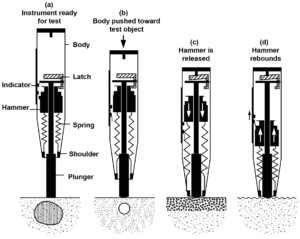
Method: A spring release mechanism is used to activate a hammer which impacts a plunger to drive into the surface of the concrete. The rebound distance from the hammer to the surface of the concrete is given a value from 10 to 100. This measurement is then correlated to the concretes’ strength. Pros: Relatively easy to use and can be done directly onsite. Cons: Pre-calibration using cored samples is required for accurate measurements. Test results can be skewed by surface conditions and the presence of large aggregates or rebar below the testing location.
Penetration Resistance Test (ASTM C803)
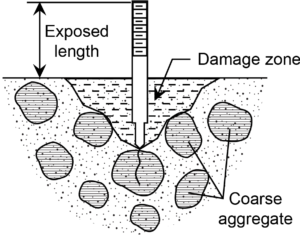
Method: To complete a penetration resistance test, a device drives a small pin or probe into the surface of the concrete. The force used to penetrate the surface and the depth of the hole are correlated to the strength of the in-place concrete. Pros: Relatively easy to use and can be done directly onsite. Cons: Data is significantly affected by surface conditions as well as the type of form and aggregates used. Requires pre-calibration using multiple concrete samples for accurate strength measurements.
Ultrasonic Pulse Velocity (ASTM C597)
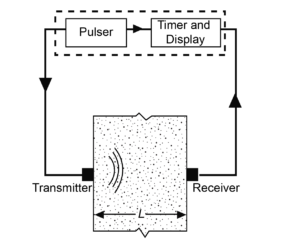
Method: This technique determines the velocity of a pulse of vibrational energy through a slab. The ease at which this energy makes its way through the slab provides measurements regarding the concrete’s elasticity, resistance to deformation or stress, and density. This data is then correlated to the slab’s strength. Pros: This is a non-destructive testing technique which can also be used to detect flaws within the concrete, such as cracks and honeycombing. Cons: This technique is highly influenced by the presence of reinforcements, aggregates, and moisture in the concrete element. It also requires calibration with multiple samples for accurate testing.
Pullout Test (ASTM C900)
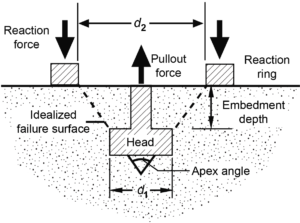
Method: The main principle behind this test is to pull the concrete using a metal rod that is cast-in-place or post-installed in the concrete. The pulled conical shape, in combination with the force required to pull the concrete, is correlated to compressive strength. Pros: Easy to use and can be performed on both new and old constructions. Cons: This test involves crushing or damaging the concrete. A large number of test samples are needed at different locations of the slab for accurate results.
Cast-in-place Cylinders (ASTM C873)
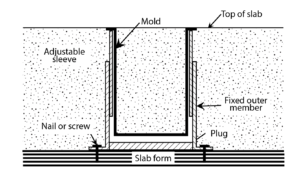
Method: Cylinder moulds are placed in the location of the pour. Fresh concrete is poured into these moulds which remain in the slab. Once hardened, these specimens are removed and compressed for strength. Pros: It is considered more accurate than field-cured specimens because the concrete is subjected to the same curing conditions as the in-place slab, unlike field-cured specimens. Cons: This is a destructive technique that requires damaging the structural integrity of the slab. The locations of the holes need to be repaired afterwards. A lab must be used to obtain strength data.
Drilled Core (ASTM C42)
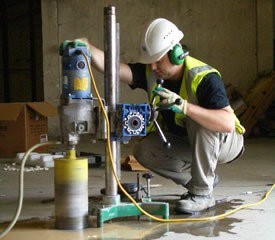
Method: A core drill is used to extract hardened concrete from the slab. These samples are then compressed in a machine to monitor the strength of the in-situ concrete. Pros: These samples are considered more accurate than field-cured specimens because the concrete that is tested for strength has been subjected to the actual thermal history and curing conditions of the in-place slab. Cons: This is a destructive technique that requires damaging the structural integrity of the slab. The locations of the cores need to be repaired afterwards. Concrete labs work to obtain the strength data.
Wireless Maturity Sensors (ASTM C1074)

Method: This technique is based on the principle that concrete quality and strength are directly related to its hydration temperature history. Wireless sensors are placed within the concrete formwork and secured on the rebar before pouring. Temperature data is collected by the sensor and uploaded to any smart device within an app using a wireless connection. This information is used to calculate the compressive strength of the in-situ concrete element based on the maturity equation that is set up in the app.
Pros: Compressive strength data is given in real-time and updated every 15 minutes. As a result, the data is considered more accurate and reliable as the sensors are embedded directly in the formwork. This means they are subject to the same curing conditions as the in-situ concrete element. As a result, no time is wasted onsite waiting for results from an external lab.
Cons: Requires a one-time calibration for each concrete mix to establish a maturity curve using cylinder break tests.
Giatec’s Solution: Compressive Strength Test of Concrete
The high-tech and rugged SmartRock® wireless sensors provide accurate real-time calculations based on the maturity method. More specifically, it allows you to collect the concrete’s temperature history, which is used to calculate the maturity index of concrete. This enables you to predict its early-age compressive strength. Keep in mind that the standard level of strength for post-tensioning is 75% and, in some cases, your concrete can reach this level of strength sooner than expected. By employing the maturity method, you will be able to closely monitor when your concrete reaches the necessary level of strength. Thus, you can know when to safely move forward post-tensioning as soon as possible!
Furthermore, as a non-destructive method, SmartRock requires its sensors to be embedded into the concrete. This eliminates the need for time-consuming and costly cylinder break tests.
Interesting in how this technology is applied on-site? Read our case study here!
The Giatec Ecosystem of Hardware and Software Solutions
SmartHub™ is a remote monitoring system that allows you access to your SmartRock data anytime, anywhere. Easily installed on rebar before pouring, these user-friendly sensors monitor in-situ temperature and field strength in real time. The Hub automatically collects this data recorded by the SmartRock sensors and uploads it to the Giatec 360™ cloud dashboard via LTE, syncing it to your team’s mobile devices in the SmartRock app. The Giatec 360 alert system sends smart notifications to let you know when your concrete reaches specific thresholds.
Giatec SmartMix™ is a web-based dashboard that enables producers to optimize concrete materials and predict the performance of their mixes. With the SmartMix dashboard, producers can adjust the proportions of their concrete mixes, such as the use of chemical admixtures and the amount of cement. With the help of Roxi™ and access to millions of data points used to train the artificial intelligence algorithm, the dashboard’s suggestions ensure that these adjustments will meet a mix’s designed compressive strength and other performance criteria.
Learn more about concrete maturity here
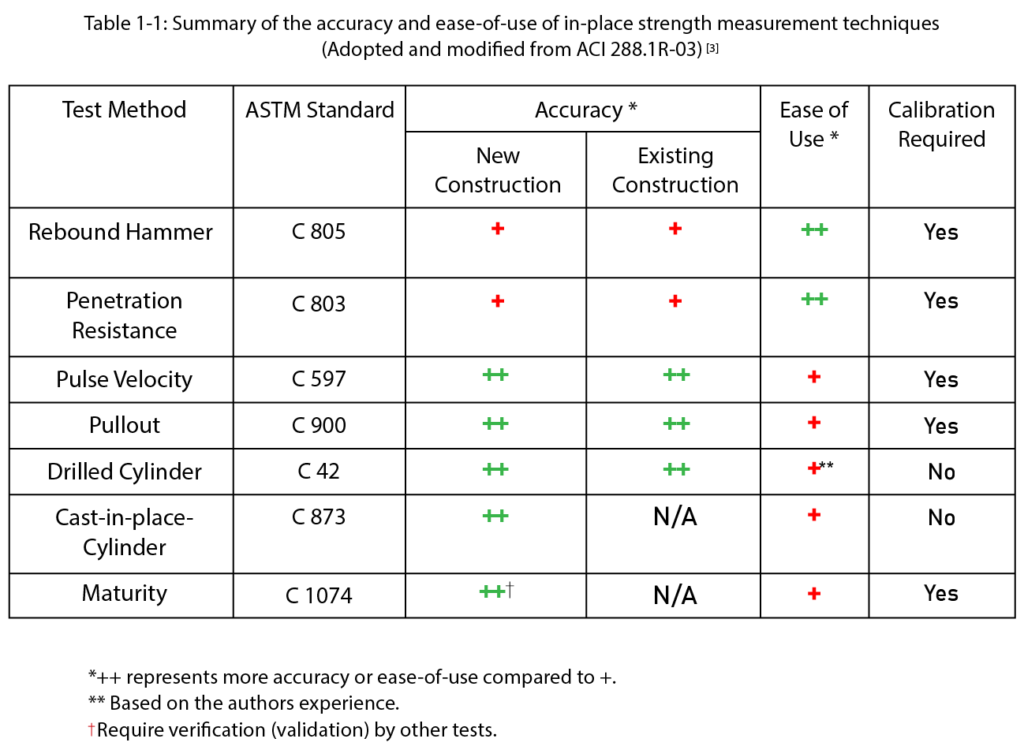
Combined Methods of Concrete Strength Measurement
A combination of these methods for measuring the compressive strength is sometimes used to ensure the concrete quality control and quality assurance of a structure. A combined method results in a more comprehensive overview of your slab. This allows you to confirm strength data by using more than one testing method. The accuracy of your strength data will also increase as using multiple methods will help account for influencing factors, such as cement type, aggregate size, and curing conditions. For example, a combination of the ultrasonic pulse velocity method and the rebound hammer test has been studied. Similarly, when using the maturity method on your jobsite to test compressive strength, it is recommended to perform cylinder break tests on day 28 of your concrete’s lifecycle for acceptance purposes and to confirm the strength of your in-situ slab.
Biggest SmartRock® Savings of the Year are Here!
How to Decide Which Concrete Field Strength Method to Use for Your Next Pour
Tests like the rebound hammer and penetration resistance technique, while easy to perform, are considered less accurate than other testing methods (Science Direct). This is because they do not examine the center of the concrete element. They only examine the curing conditions directly below the surface of the slab. Practices, such as the ultrasonic pulse velocity method and the pullout test, are more difficult to perform as their calibration process is lengthy. This requires many sample specimens to obtain accurate data.
Destructive Testing vs. The Maturity Method
As destructive testing techniques, the drilled core and cast-in-place cylinder methods need other parties to perform break tests in order to get data. As a result, more time is needed in your project schedule when using either of these methods. Comparatively, with the maturity method, you can get strength data in real-time directly on-site, allowing for well-informed and quick decision-making. By reducing your reliance on break tests, you can also avoid inaccuracies associated with testing labs.
Learn more about wireless concrete sensors, like SmartRock® Here
Conclusion
Your decision in choosing a testing method for concrete strength measurement may simply come down to familiarity. However, the accuracy of these tests and the time they take to obtain strength data are significant factors that are often overlooked. Think about where all your time and money go during the construction of a project. How much of that is spent on repairs, fees for labs, and extra labour to make sure your project finishes on time? The accuracy of the technique you choose can lead to future durability and performance issues of your concrete structure. Furthermore, choosing a technique that takes additional time to receive strength data can be detrimental to your project deadlines. This negatively impacts productivity on your jobsite. Conversely, choosing the right tool can positively impact project timelines and allow you to finish the project below budget. How do you decide which strength testing method to use?

Frequently Asked Questions
What is concrete measurement in construction?
Concrete measurement refers to methods used to assess properties like strength, temperature, and maturity of concrete during and after placement. Accurate concrete measurement ensures safety, quality, and schedule efficiency.
Which concrete measurement method is most reliable in the field?
Wireless maturity sensors, compliant with ASTM C1074, are widely trusted for their real-time data on strength and temperature. When properly calibrated, they can provide greater accuracy than traditional cylinder tests.
Are maturity sensors accepted in construction projects?
Yes, maturity sensors are recognized under ASTM C1074 and are accepted in many project specifications. However, some still require validation using traditional cylinder breaks.
When should destructive concrete measurement methods be used?
Destructive methods like core testing or pullout testing are best for post-construction verification when non-destructive methods are inconclusive or not available.
What are the main limitations of traditional concrete measurement tools?
Field-cured cylinders and rebound hammers are prone to temperature variation, handling errors, and only offer delayed or surface-level insight. These limitations make modern concrete measurement methods, like wireless sensors, more practical on today’s job sites.
Sources:
Science Direct
Concrete Maturity: From Theory to Application
Concrete Network
*Editor’s Note: This post was originally published in April 2019 and has since updated for accuracy and comprehensiveness in November 2025.

